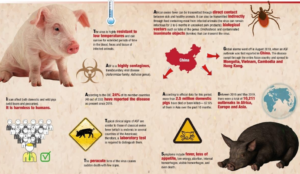In news
Pigs in Mon, Kiphire and Phek districts of Nagaland were affected by African Swine Fever, recently
African Swine Fever(ASF)
- It is a highly contagious hemorrhagic viral disease of domestic and wild pigs.
- It is caused by a large double strained DNA virus of the Asfarviridae family, which also infects ticks of the genus Ornithodoros.
- ASF is a disease listed in the World Organisation for Animal Health’s Terrestrial Animal Health Code and must be reported to it.
- The epidemiology of ASF is complex and varies depending on the environment, types of pig production systems, the presence/ absence of competent tick vectors, human behaviour, and the presence/ absence of wild pigs.
- The virus causes a hemorrhagic fever with high mortality rates in domestic pigs; some isolates can cause death of animals as quickly as a week after infection.
- It persistently infects its natural hosts, warthogs, bushpigs, and soft ticks of the genus Ornithodoros, which likely act as a vector, with no disease signs

Routes of transmission can include:
- Direct contact with infected domestic or wild pigs.
- Indirect contact, through ingestion of contaminated material (e.g. food waste, feed, or garbage).
- Contaminated fomites, or biological vectors (soft ticks of the genus Ornithodoros).
- Clinical signs and mortality rates can vary according to the virulence of the virus and the type/ species of pig. ASF however is not a risk to human health.
- Acute forms of ASF are characterised by high fever, depression, anorexia and loss of appetite, haemorrhages in the skin (redness of skin on ears, abdomen and legs), abortion in pregnant sows, cyanosis, vomiting, diarrhoea and death within 6-13 days (or up to 20 days).
- Mortality rates may be as high as 100%.
- Subacute and chronic forms are caused by moderately or low virulent viruses, which produce less intense clinical signs that can be expressed for much longer periods.
- Mortality rates are lower, but can still range from 30-70%.
- Chronic disease symptoms include loss of weight, intermittent fever, respiratory signs, chronic skin ulcers and arthritis.
- African wild suids may be infected without showing clinical signs allowing them to act as reservoirs.
- Currently there is no approved vaccine for ASF.
Prevention
- Prevention in countries free of the disease depends on implementation of appropriate import policies and biosecurity measures, ensuring that neither infected live pigs nor pork products are introduced into areas free of ASF.
- This includes ensuring proper disposal of waste food from aircraft, ships or vehicles coming from affected countries and policing illegal imports of live pigs and pork products from affected countries.
- Classic sanitary measures may be employed including early detection and humane killing of animals (with proper disposal of carcases and waste); thorough cleansing and disinfection; zoning/ compartmentalisation and movement controls; surveillance and detailed epidemiological investigation; strict biosecurity measures on farms.
World Organisation for Animal Health
- It was founded in 1924
- The World Organisation for Animal Health, formerly the Office International des Epizooties, is an intergovernmental organization coordinating, supporting and promoting animal disease control.
- The main objective of the OIE is to control epizootic diseases and thus to prevent their spread.
- Other objectives consist of: transparency, scientific information, international solidarity, sanitary safety, the promotion of Veterinary Services, food safety and animal welfare
- Head quarters: Paris
- The recent innovation of the World Animal Health Information System (OIE-WAHIS) system is a testimony to the OIE’s progressive evolution of its digital services.
- The platform provides Members with a new tool for animal disease surveillance for strengthened risk analysis and the monitoring during disease emergencies.
- It is recognized as a reference organisation by the World Trade Organization (WTO) and in 2018 had a total of 182 member states.
- India is also a member country.
















